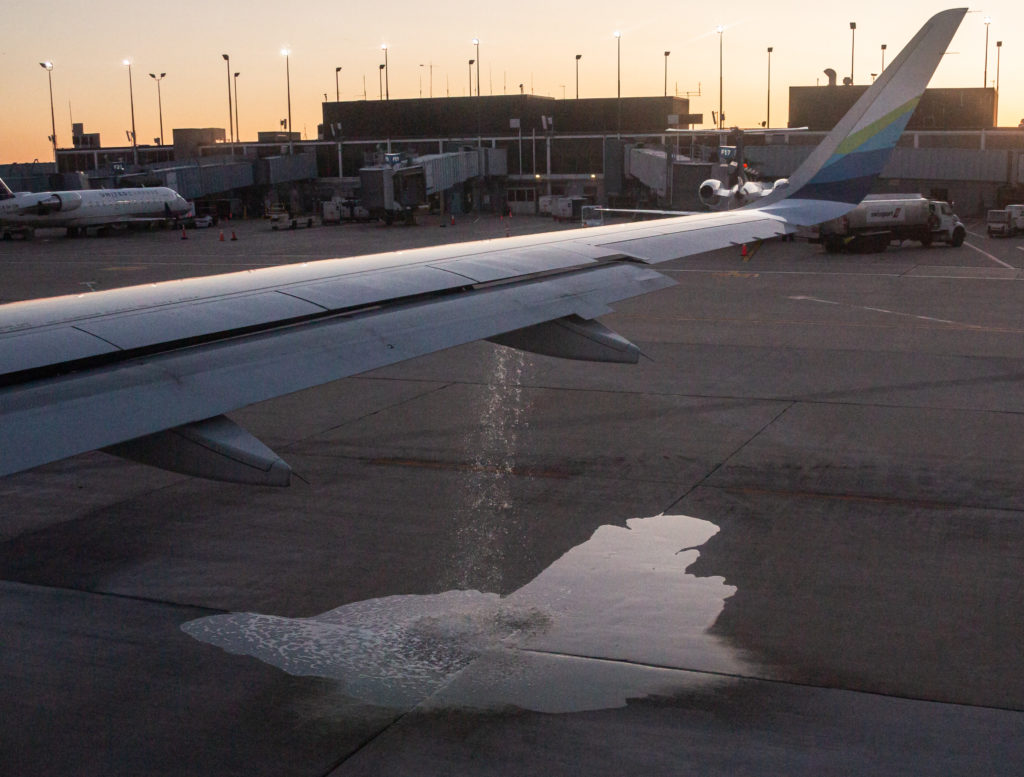
We were in Chicago for a wedding last week and flew back to San Francisco on Monday. We got to the airport in plenty of time and discovered our flight was a little late. No worries.
We found a place to sit that had a view of the plane’s parking space and of the jetway at our gate. The incoming flight was later than advertised, finally pulling up and shutting down maybe 25 minutes late. I watched as the jetway was extended toward the plane to allow the arriving passengers to escape their confinement. But the apparatus stopped about 10 feet short of its target. The ground crew tried to retract it and re-extend it. They couldn’t get it to close the gap.
As the minutes went by, I was imagining the slow burn the passengers stuck on the plane were doing. I was wondering whether someone would appear with a couple of planks for people to walk across from jet to jetway.
What actually happened , after 20 minutes or so, was that two guys from American Airlines showed up. One of them got a step ladder and set it up adjacent to what looked like an electrical box on the jetway. Then he climbed up, took a “hundreds of Americans die every year doing stunts like this” stance, with one foot on the ladder and the other on the electrical box, and fiddled for about 10 seconds with a switch. He climbed down and signaled to someone to give the jetway a try. This time it worked. So at about 5:50, roughly 35 minutes after the plane parked, and about the exact time Flight 1213 was scheduled to pull away from the gate for the trip to San Francisco, the arriving passengers could get off.

It took about 30 minutes for everyone to make their way off the airliner and for a cleaning crew to race through the aircraft and straighten it up. Then it was our turn to get on, and I’m guessing another 20 minutes or so to hustle everyone on board. We pulled back from the gate at about 6:40, 50 minutes late, but not a disaster.
Once we were pointed toward the taxiway, but still just 50 yards or so from the gate, we had to sit for awhile to get in the takeoff queue. I was sitting pretty far back, looking out the window on the plane’s right side. Suddenly, liquid began spouting out of the wing. A lot of fluid. It kept going. What was it? Water? That didn’t make sense. Jet fuel? that wouldn’t be good. While I was pondering this mystery, which I thought someone ought to point out to the crew, someone else a few rows ahead of me said, “Hey! Look at this! Something’s coming out of the wing!”
That got a flight attendant’s attention. She looked out a window. Another crew member said, “Call them and tell them.” One of the flight attendants reassured us that there was nothing to worry about.
The liquid kept cascading to the ground. The flow gradually slowed, then stopped. Hard to say how much spilled onto the tarmac. One hundred gallons? Five hundred? Eventually, the flight’s captain got on the PA and confirmed that we had been seeing jet fuel spilling. More than once, he suggested that it had been a normal occurrence and tried to explain what happened. I’m not sure I understood, but it sounded like an issue with having failed to properly balance the fuel load between the aircraft’s tanks and that a valve had opened — to relieve fuel line pressure? — and released fuel onto the ground. (As I say, I’m not sure I understood the details. I’d love to have an Airbus mechanic explain it again.)
In any case, we had to go back to the gate so maintenance technicians could check out the issue. Then the plane took on additional fuel. Then paperwork had to be done. The plane was opened up so people could wander around the terminal if they liked — but not too far! — and maybe grab a snack. The woman setting next to Kate and me came back with pizza slices.
All of that consumed another two hours. Kate and I did not leave the plane, though we got up a couple times to stretch. Finally, all the checking and rechecking was done, the wandering passengers were called back, and at 8:40 — now nearly three hours after our scheduled departure, we again pulled back from the gate.
All that stood between us and actual flight now was the long line of airliners waiting to take off ahead of us. The wait for our turn turned out to be another 40 minutes, making our departure nearly three hours and 20 minutes late. I was hoping Alaska would spring for free beer, or at least beer nuts, as compensation for the delay. No such luck.
Long story short: We made good time to SFO, and were off our plane by 11:35 p.m. (1:35 a.m. Chicago time). I had visions of making the last cheapskate BART train back to the East Bay. But by the time we had collected our bags and made it up to the AirTrain for the ride to the BART stop, it was too late. We wound up taking a Lyft ride instead — kind of a treat, actually, and we didn’t have to schlep our bags the last couple blocks home from the station.
I was thinking about complaining to Alaska as all this was unfolding. But then I got a personal message from the airline that came in just as our plane landed. It made me feel kind of … well, see for yourself.

